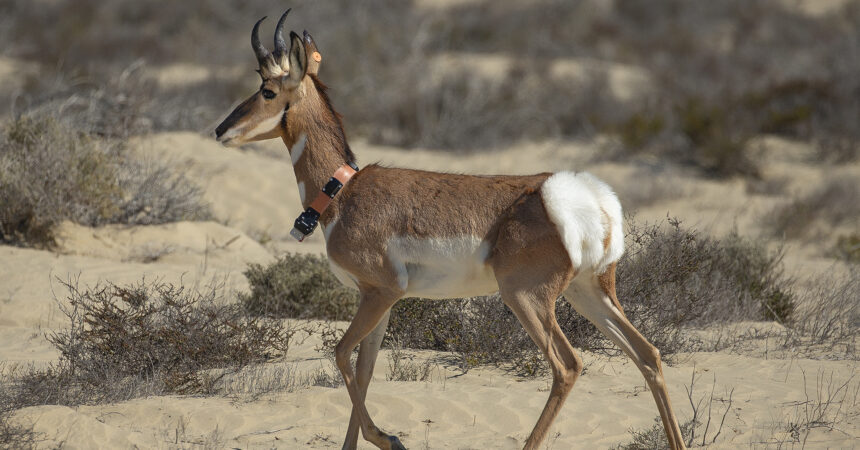Bi-National Collaborative Effort to Save Elusive Species Uses Cutting-Edge Technology to Advance Conservation Efforts
SAN DIEGO Jan. 20, 2022) –—For the first time, wildlife conservationists in a bi-national collaborative partnership to save endangered peninsular pronghorn can now track their movements across harsh desert terrain in the El Vizcaino Biosphere Preserve in Baja California Sur, Mexico.
Eight pronghorn antelope were recently fitted with technologically advanced solar-powered, GPS-enabled radio collars that send location updates to a satellite every 15 minutes for up to three years. These movements are plotted against a map and overlaid with landscape data to paint a descriptive picture of the lives of these rare animals. This information could help save them.
There are fewer than 50 peninsular pronghorn antelope remaining in the wild, under 500 in managed reserves in Baja California, Mexico and 40 in an assurance population in zoos in the U.S. The peninsular pronghorn antelope is one of the fastest mammals on Earth, and they live in a harsh environment that makes tracking and studying them a grueling and nearly impossible feat. Advances in conservation technology tools are helping scientists fill information gaps, shedding light on how the animals use the landscape so specific protection efforts that will have the greatest impacts can be made.
“The lightweight, powerful technology has only recently become available. In just a few weeks we have already learned a great deal. This will significantly advance our understanding about what this endangered species needs to survive and thrive and will inform conservation measures in the future,” said James Sheppard, recovery ecology scientist, San Diego Zoo Wildlife Alliance.
This pronghorn subspecies is the most at risk of extinction of the three subspecies. They used to exist in Southern California, but threats from loss of habitat and fragmentation due to fences and roads that limit their movement, lack of access to water, removal of native vegetation in their habitat and illegal hunting have taken a toll on their population.
The multi-agency, bi-national partnership to protect the species includes researchers and wildlife care specialists from San Diego Zoo Wildlife Alliance; the Los Angeles Zoo and Botanical Gardens; Fossil Rim Wildlife Center and the El Paso Zoo; the Peninsular Pronghorn Recovery Project (PPRP); the National Commission of Natural Protected Areas (CONANP) Mexico, and local land managers in Mexico.
The Peninsular Pronghorn Recovery Project (PPRP) is a comprehensive and multifaceted conservation program, working to establish sustainable populations of the species in managed native habitats in Baja California and assurance populations in accredited zoos.
Recovery efforts for this species began in 1997 when the population was fewer than 170 animals. “These new collars will advance the successes of the Peninsular Pronghorn Recovery Project even further,” said Melodi Tayles, wildlife care manager and Peninsular Pronghorn Species Survival Plan coordinator, San Diego Zoo Wildlife Alliance. “It is also a perfect example of the value of collaboration with good conservation partners, working to make a difference for wildlife.”





